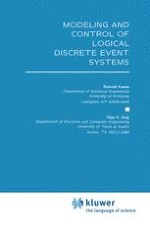1995 | OriginalPaper | Chapter
Control of Non-Terminating Behavior
Authors : Ratnesh Kumar, Vijay K. Garg
Published in: Modeling and Control of Logical Discrete Event Systems
Publisher: Springer US
Included in: Professional Book Archive
Activate our intelligent search to find suitable subject content or patents.
Select sections of text to find matching patents with Artificial Intelligence. powered by
Select sections of text to find additional relevant content using AI-assisted search. powered by
So far we have restricted our attention to behaviors consisting of finite length strings. Such behaviors are useful in describing safety properties of a system, i.e., those properties which state that some conditions must never occur. In this chapter we will study supervisory control of behaviors consisting of infinite length strings. Such behaviors are useful in describing progress properties of a system, i.e., those properties which state that some conditions must occur eventually. In general it is not possible to express such progress constraints as constraints on finite length strings. Consider for example a communication system in which every transmitted message must be received eventually. Since each finite length trace of the communication system can be extended in a manner such that the above constraint is satisfied, this constraint does not impose any restriction on finite length traces of the communication system. However, it is clear that it imposes restriction on traces of infinite length. Thus there is a need to separately study issues related to behaviors consisting of infinite length strings, or non-terminating behaviors. Such behaviors are represented using ω-languages. In order to avoid any confusion, we use the term *-language to denote a set of finite length strings.
